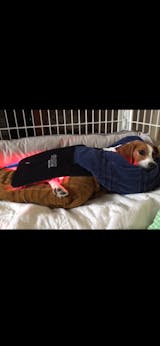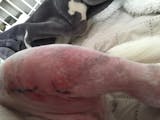We belong to the North American Association for Light Therapy (Photobiomodulation), an organization devoted to research and understanding of therapeutic light. This organizations and it's researchers have been invaluable to us with their generosity and sharing of their knowledge. Please feel free to share these studies with your clients and healthcare professionals.
Equine wound healing: influence of low level laser therapy on an equine metacarpal wound healing model
Objective: To evaluate the effects of low level laser therapy (LLLT) on healing of full thickness symmetrical skin wounds in horses. LLLT is a therapeutic modality using the application of light, usually a low power laser or light emitting diode in the power range of 1 mW to 12 W that, in practical terms, promotes tissue regeneration as well as reducing inflammation and pain.
Study design: Experimental study.
Animals: Healthy horses (n=8).
Results: Wounds treated with LLLT healed faster than the control wounds (p=0.01). Wounds treated with LLLT were completely epithelialized at day 80 after surgery. Control wounds were not epithelialized at postoperative day 80. Conclusion: LLLT increased the rate of wound healing.
Click here to read more
Transcranial LED to Treat Traumatic Brain Injury (Chronic TBI)
Margaret A. Naeser, Ph.D. talks about new treatment for traumatic brain injury.
Photobiomodulation Therapy Versus Extracorporeal Shock Wave Therapy in the Treatment of Lateral Epicondylitis
Objective: To compare the effects of photobiomodulation therapy (PBMT) and extracorporeal shock wave therapy (ESWT) on lateral epicondylitis (LE).
Results: Improvements for elbow extension and shoulder flexion strength and for VAS movement were observed only in the PBMT group, whereas improvement of handgrip strength was present in both groups ( p < 0.05). However, handgrip strength was superior in the PBMT group than in the ESWT group ( p = 0.02). Conclusions: Both PBMT and ESWT are useful and can be used in the treatment of LE.
Click here to read more
Photobiomodulation or low-level laser therapy
Michael R. Hamblin, Ph.D. Wellman Center for Photomedicine, Massachusetts General Hospital, Boston, MA, USA Department of Dermatology, Harvard Medical School, Boston, MA, USA Harvard-MIT Division of Health Sciences and Technology, Cambridge, MA, USA
Since those early days, it has been consistently found that one did not, in fact, need to use a coherent monochromatic laser to obtain these beneficial biological effects, but rather noncoherent light-emitting diodes (LEDs) with comparable parameters to low power lasers performed equally well. Considering that lasers were shown not to be necessary, the fact that “low-level” was considered a subjective term and nobody knew exactly what the term “low” actually meant, the fact that both inhibition as well as stimulation of biological processes could be therapeutically useful, the decision was eventually made to change the name to “photobiomodulation (therapy)” abbreviated PBM(T) depending on whether the process or a treatment is being discussed [4].
Click here to read more
A Preliminary Study of the Safety of Red Light Phototherapy of Tissues Harboring Cancer
Max Myakishev-Rempel, Ph.D.,1 Istvan Stadler, Ph.D.,2 Philip Brondon, M.D.,2 David R. Axe, M.Sc.,1 Mark Friedman, Ph.D.,3 Frances Barg Nardia, M.Sc.,1 and Raymond Lanzafame, M.D., M.B.A.2
Abstract
Objective: Red light phototherapy is known to stimulate cell proliferation in wound healing. This study in- vestigated whether low-level light therapy (LLLT) would promote tumor growth when pre-existing malignancy is present. Background data: LLLT has been increasingly used for numerous conditions, but its use in cancer patients, including the treatment of lymphedema or various unrelated comorbidities, has been withheld by practitioners because of the fear that LLLT might result in initiation or promotion of metastatic lesions or new primary tumors. There has been little scientific study of oncologic outcomes after use of LLLT in cancer patients. Methods: A standard SKH mouse nonmelanoma UV-induced skin cancer model was used after visible squa- mous cell carcinomas were present, to study the effects of LLLT on tumor growth. The red light group (n = 8) received automated full body 670 nm LLLT delivered twice a day at 5 J/cm2 using an LED source. The control group (n = 8) was handled similarly, but did not receive LLLT. Measurements on 330 tumors were conducted for 37 consecutive days, while the animals received daily LLLT. Results: Daily tumor measurements demonstrated no measurable effect of LLLT on tumor growth. Conclusions: This experiment suggests that LLLT at these parameters may be safe even when malignant lesions are present. Further studies on the effects of photo- irradiation on neoplasms are warranted.
Click here to read more
Exposure to Near Infrared Light Alters the Temporal Expression of Bone Morphogenetic Proteins: Implications for the Enhancement of Fracture Healing
1Pitts, T C; 2Weihrauch D W; 1Struve, J A; Marshall S A; Davidson R; +1Ninomiya J T +1Department of Orthopaedics, Medical College of Wisconsin, Milwaukee WI; 2Department of Anesthesiology, Medical College of Wisconsin, Milwaukee WI jninomi@attglobal.net
"Recently, investigators have shown that treatment of fractures with near infrared light (NIR) increases bone callus formation and bone mineral density in the early stages of fracture healing. Our lab recently showed that NIR exposure decreases osteoblast apoptosis (cell death) and promotes cell proliferation."
Click here to read more
Photomedicine, Not Opioids, for Chronic Pain
Narda G. Robinson, DO, DVM, MS, FAAMA
"Although many who practice photomedicine in clinical settings know that light therapy can provide rapid, safe, and noninvasive analgesia, most medical practitioners remain unaware and/ or unconvinced of its value. They live in the dark, not realizing that photomedicine effectively treats a variety of nociceptive and neuropathic pain problems from head to toe, all with a notably low risk profile. Whereas opioids lead to addiction, photomedicine leads to healing. Photobiomodulation repairs tissue, relaxes muscles, reduces inflammation and edema, and restores circulation as well as nerve function to more normal levels. No opioid can match the reparative value of light. It is time for photomedicine practitioners to educate the public and the medical profession about this valuable, cost-effective, and well-received treatment option. You can bet the drug companies will not."
Click here to read more
Photobiomodulation (Laser and Led) On Sternotomy Healing in Hyperglycemic and Normoglycemic Patients Who Underwent Coronary Bypass Surgery with Internal Mammary Artery Grafts: A Randomized, Double-Blind Study with Follow-Up
Wow, this is very interesting. Both Laser and LED had very similar effects on increased healing! Andre´ a Conceic¸ a˜ o Gomes Lima, PT, MS, Gilderlene Alves Fernandes, PT, MS Raimundo de Barros Arau´ jo, MD, Isabel Clarisse Gonzaga, PT, MS, Rauirys Alencar de Oliveira, PT, PhD, and Renata Amadei Nicolau, PhD
"The mechanisms involved in enhanced tissue repair with LLLT and LED therapy include an increase in the number of dividing cells and increases in the levels of inducible nitric oxide synthase, keratinocyte growth factor, and keratinocyte growth factor receptor, which may facilitate earlier and thicker re-epithelization.33 At doses of 5–6 J/cm2, LLLT can stimulate the production of bFGF, a multi-functional polypeptide that supports fibroblast proliferation and differentiation. Further, high doses suppress bFGF.34 The effects of the laser and LED sources were comparable when equal therapeutic doses of light were applied. The result was an improved healing process, which can be observed on sternotomy incisions after a protocol of irradiation."
Click here to read more
Study on Light Emitting Diode Treatments in Traumatic Brain Injury
This is a must read!!
Margaret A. Naeser, Ph.D., L.Ac.,1,2 Anita Saltmarche, R.N., M.H.Sc.,3 Maxine H. Krengel, Ph.D.,1,2 Michael R. Hamblin, Ph.D.,4,5,6 and Jeffrey A. Knight, Ph.D.1,2,7
Objective: Two chronic, traumatic brain injury (TBI) cases, where cognition improved following treatment with red and near-infrared light-emitting diodes (LEDs), applied transcranially to forehead and scalp areas, are presented. Results: Seven years after closed-head TBI from a motor vehicle accident, Patient 1 began transcranial LED treatments. Pre-LED, her ability for sustained attention (computer work) lasted 20 min. After eight weekly LED treatments, her sustained attention time increased to 3 h. The patient performs nightly home treatments (5 years); if she stops treating for more than 2 weeks, she regresses. Patient 2 had a history of closed-head trauma (sports/military, and recent fall), and magnetic resonance imaging showed frontoparietal atrophy. Pre-LED, she was on medical disability for 5 months. After 4 months of nightly LED treatments at home, medical disability discontinued; she returned to working full-time as an executive consultant with an international technology consulting firm. Neuropsychological testing after 9 months of transcranial LED indicated significant improvement (þ1, þ2SD) in executive function (inhibition, inhibition accuracy) and memory, as well as reduction in post-traumatic stress disorder. If she stops treating for more than 1 week, she regresses. At the time of this report, both patients are continuing treatment. Conclusions: Transcranial LED may improve cognition, reduce costs in TBI treatment, and be applied at home.
Click here to read more
We have seen some amazing recovery stories involving nerve damage!!
Effect of near-infrared light-emitting diodes on nerve regeneration
RESULTS: Nerve regeneration was promoted in the LED group. Antioxidation of the chamber fluid significantly decreased from 3 days to 7 days in the control group. In the LED group, antioxidation levels did not decrease until 7 days. CONCLUSIONS: Chamber fluid is produced from nerve stumps after nerve injury. This fluid contains neurotrophic factors that may accelerate axonal growth. Red to near-infrared LEDs have been shown to promote mitochondrial oxidative metabolism. In this study, LED irradiation improved nerve regeneration and increased antioxidation levels in the chamber fluid. Therefore, we propose that antioxidation induced by LEDs may be conducive to nerve regeneration.
Effect of NASA Light-Emitting Diode Irradiation on Wound Healing
Click here to read more
This study shows how light therapy can be used to PREVENT injury! A lot of our clients with performance animals use our Light Therapy pads before they compete, here's why!!
Comparison Between Single-Diode Low-Level Laser Therapy(LLLT) and LED Multi-Diode (Cluster) Therapy (LEDT)Applications Before High-Intensity Exercise
Click here to read more
This is a wonderful paper which goes into depth in discussion and explanation of the mechanisms of light for healing.
Biphasic Dose Response in Low Level Light Therapy
Click here to read more
This study was done with humans, but we all know that when we are bringing back our animal partners from injury,they can get sore too!! I think it can easily be applied to our equines and canines in rehabilitation!
Effect of Phototherapy on Delayed Onset Muscle Soreness
Click here to read more
Clinical and Experimental Applications of NIR-LED Photobiomodulation
Click here to read more
Guess what?? Light Therapy won!
Comparative Effects of Low-Intensity Pulsed Ultrasound and Low-Level Laser Therapy on Injured Skeletal Muscle
Click here to read more
Arthritis? Light Therapy can help!
Effect of light-emitting diode (LED) therapy on the development of osteoarthritis (OA) in a rabbit model
Click here to read more
Mitochondrial Signal Transduction in Accelerated Wound and Retinal Healing by Near-Infrared Light Therapy
Click here to read more
USA Today: 'Light That Can Cure You'
Click here to read more
NASA Science Blog
Click here to read more
Comparative analysis of coherent light action (laser) versus non-coherent light (light-emitting diode) for tissue repair in diabetic rats
Click here to read more









